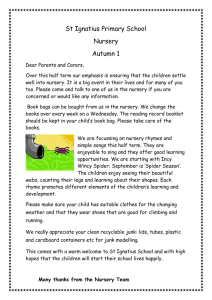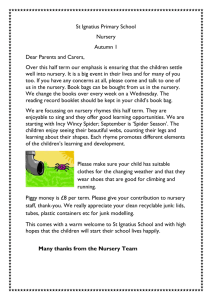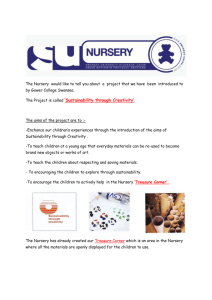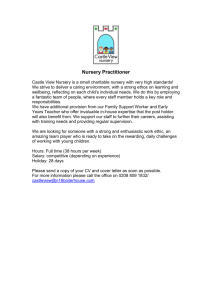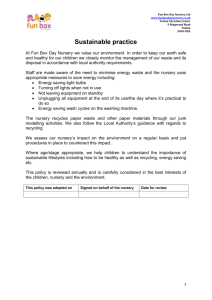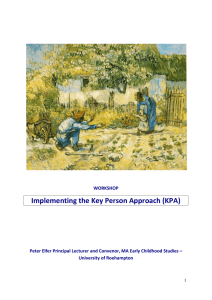V2 GPE template - EY - 6Mar2012
advertisement
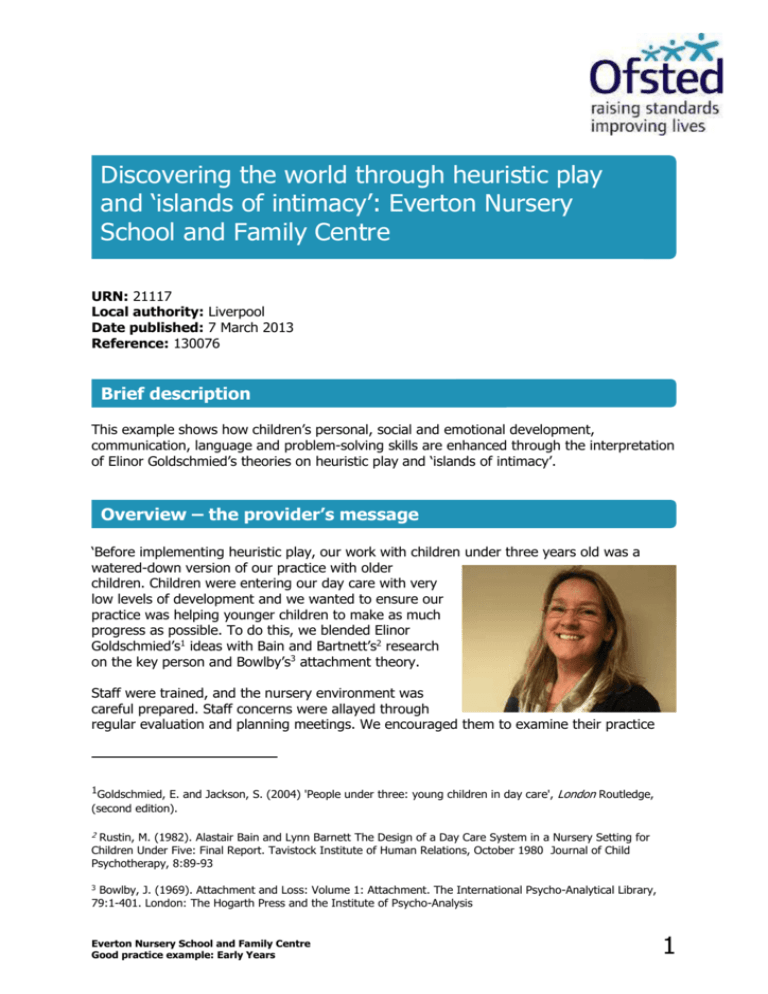
Discovering the world through heuristic play and ‘islands of intimacy’: Everton Nursery School and Family Centre URN: 21117 Local authority: Liverpool Date published: 7 March 2013 Reference: 130076 Brief description This example shows how children’s personal, social and emotional development, communication, language and problem-solving skills are enhanced through the interpretation of Elinor Goldschmied’s theories on heuristic play and ‘islands of intimacy’. Overview – the provider’s message ‘Before implementing heuristic play, our work with children under three years old was a watered-down version of our practice with older children. Children were entering our day care with very low levels of development and we wanted to ensure our practice was helping younger children to make as much progress as possible. To do this, we blended Elinor Goldschmied’s1 ideas with Bain and Bartnett’s2 research on the key person and Bowlby’s3 attachment theory. Staff were trained, and the nursery environment was careful prepared. Staff concerns were allayed through regular evaluation and planning meetings. We encouraged them to examine their practice 1Goldschmied, E. and Jackson, S. (2004) 'People under three: young children in day care', London Routledge, (second edition). 2 Rustin, M. (1982). Alastair Bain and Lynn Barnett The Design of a Day Care System in a Nursery Setting for Children Under Five: Final Report. Tavistock Institute of Human Relations, October 1980 Journal of Child Psychotherapy, 8:89-93 3 Bowlby, J. (1969). Attachment and Loss: Volume 1: Attachment. The International Psycho-Analytical Library, 79:1-401. London: The Hogarth Press and the Institute of Psycho-Analysis Everton Nursery School and Family Centre Good practice example: Early Years 1 with the under-threes before, during and after the introduction of treasure baskets, heuristic play and ‘islands of intimacy’, to assess what difference it was making. We have found that this way of working deepens children’s learning and improves their well-being. The improvement in children’s problem solving and communication and language skills is confirmed by nursery school colleagues following transition to the on-site nursery. To share our methods and celebrate our results, we produced a booklet and DVD which we use for training staff, informing parents and carers, and for sharing with colleagues in other settings.’ Andrea Vaughan, Day Care Manager. The good practice in detail The term ‘heuristic’ derives from the Greek ‘eurisko’, meaning ‘to discover’, and promotes investigative play using all of the senses. Heuristic play ‘the Everton way’ starts with treasure basket play for non-mobile babies; followed by indoor heuristic play for the more active babies and toddlers; and additional ‘islands of intimacy’ time solely for two-year-olds. Three-to-five-year-old children mainly experience heuristic play outdoors. Heuristic play takes place in carefully planned sessions dedicated to exploring the properties of everyday objects and materials. Natural materials are used indoors supplemented by cheaply available resources or free recycled materials outside; so it is inexpensive to replicate at home or in other settings. Treasure basket play for very young babies Babies sit alongside a low-level wicker basket, about 14 inches in diameter, full to the brim with interesting, non-plastic items offering them safe, multi-sensory stimulation. Objects might include lemons, bunches of keys, small metal and wooden objects such as curtain rings, loofas, woollen pom-poms, samples of material with inviting textures, shells, stones and thick cardboard tubes. Items are light, easy for babies to grip and safe enough to be explored by mouth. Heuristic play for mobile babies Sessions usually last no more than 45 minutes, including 15 minutes tidying up time with the children, but the time is dependent upon how long the child wishes to participate. Notices on all the entrances to the area prevent unnecessary interruptions to children’s concentration. Child-height windows into the adjacent playrooms are also covered, to encourage children to investigate the resources without distraction. The sessions involve containers of different sizes into which items from the many large collections of natural objects can be placed. This helps babies to learn that things still exist when out of sight (object 2 Everton Nursery School and Family Centre Good practice example: Early Years permanence). The more mobile babies purposefully organise and arrange the play items, concentrating intensely as they try to fit objects inside one another, experiment with the sounds items make or just enjoy the range of textures. Having enough for all to share without conflict is important with this age range. These sessions are at the beginning and end of each week, to ensure equal access for children who may only attend at these times. ‘Islands of intimacy’ for two-year-olds What makes ‘island time’ different from either heuristic play or the more typical childinitiated play is that it is focused interaction specifically organised to respond to two-yearolds’ need for close relationships with the keyworkers. Island time starts on the ‘island’ – a special rug only used during this session - and is characterised by a flow of meaningful, directed praise about what children are doing, saying and sharing. It is usually organised just before lunch, to bring a calming sense of what Andrea describes as ‘awe and wonder, delight and thrill’ into what can sometimes be stressful, unproductive transition time for children. Children can show or discuss what they have been doing, and because this time is led by the children, they may then decide to go outdoors, or continue a previous activity, or they may choose just to sit quietly and be held for a while. It complements other types of play very effectively. A wide selection of resources, stored in small colourful baskets and used only for island time, is available to extend the children’s interests. Baskets may contain themed books supporting the activities, interesting collections like shells, buttons or cones, or unusual resources such as shark’s eggs (sometimes called mermaid’s purses). They provide highly effective opportunities for language development. Heuristic play for two- to five-year-olds This is set up on a much larger scale, both indoors and outside, to reflect the children’s developing agility in running and climbing and their growing ability to carry and transport their equipment. By the time the children are three to five years old, heuristic play has advanced into constructing bridges, trains, balancing beams, dens and towers; using easily available resources such as milk crates and bakers’ trays. Children use plumbing equipment, guttering and large stones in water play to explore the flow of water and investigate gravity. They remain engrossed in their self-initiated learning for extensive periods. So what makes this different from the usual, hands-on multisensory exploratory play? The role of the adult in heuristic play is that of a quiet observer, recording the child’s interests, but being careful not to interrupt or guide the exploration. Adults offer neither praise nor direction other than making eye contact and smiling when children need reassurance, so acting as an ‘emotional anchor’ during the activity. Children therefore explore the resources without any subtle influence by adults, such as affirming children’s Everton Nursery School and Family Centre Good practice example: Early Years 3 choices by verbal praise or body language like smiling and nodding. This type of support aids choice and independent learning. Information from the observations informs the way staff plan the rest of the child’s experience in the setting, capitalising on their interests to provide similar resources and activities to be shared and discussed with adults. This consolidates and extends the children’s learning. The information is used to complete assessments of children’s progress against the expectations of Development Matters. Tidying away is a vital part of the play, developing independence and encouraging care for the environment. It is the only time during heuristic play that practitioners explicitly interact with children, and let the children know that this part of the day is coming to an end. It takes approximately 15 minutes, but is always unhurried. Staff say ‘thank you’ rather than ‘good boy’ or ‘good girl’, ensuring targeted praise rewards specific behaviour, rather than simply acknowledging compliance. Naming of the objects being tidied away gives additional meaning to the activity; and the tidying up gives a sense of completion to the task. What difference is this making to children’s learning and development? The heuristic play sessions develop the characteristics of effective learning – playing and exploring, active learning, and creating and thinking critically. The activities increase children’s attention, concentration and sustained investigation. Babies have been observed to remain engrossed in exploratory treasure basket play for up to 45 minutes, showing more persistence when problem-solving and taking more risks with new experiences. Staff have discovered that this correlates with increased levels of happiness and well-being in the babies, as measured by the Ferre Laevers well-being and involvement scales. Observations and assessment confirm that deep levels of involvement in their play is resulting in good learning and progress for older children too. When the children attend nursery school, nursery staff report noticeably better level of readiness for the next stage in their learning, compared with that of their peers from other settings. So successful have the staff at Everton been in promoting what manager Andrea Vaughan calls ‘deep learning experiences through heuristic play’ that she, and centre manager Lesley Curtis were invited to share their work at the 2012 symposium of the European Early Childhood Education Research Association in Portugal (EECERA) to an international audience of academics and early childhood practitioners. Provider background Everton Nursery School and Family Centre is a Phase 1 children’s centre delivering the full core offer to an area in the top 1% most deprived in relation to income, employment and health. It has been on the same site since 2001, as Everton Road Nursery School, as an 4 Everton Nursery School and Family Centre Good practice example: Early Years early childhood centre, a Sure Start Local Programme and as an Early Excellence Centre. An integrated nursery school and day care provision on site offers care and education for up to 214 children from birth to five years. Are you thinking of putting these ideas into practice; or already doing something similar that could help other providers; or just interested? We'd welcome your views and ideas. Get in touch here. To view other good practice examples, go to: www.ofsted.gov.uk/resources/goodpractice Everton Nursery School and Family Centre Good practice example: Early Years 5

